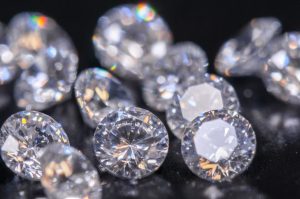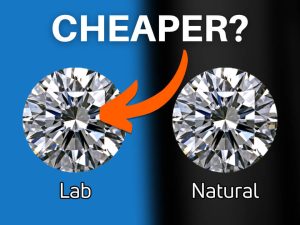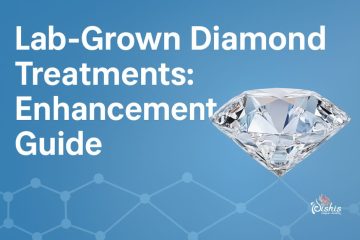The diamond industry has gone through some significant changes in the last few years. Lab Grown diamonds jewellery are gaining popularity even as engagement rings when compared to natural diamonds, with prices being more appealing than ever. This entire guide will discuss the major distinctiveness between lab-created diamonds and natural diamonds so that one can make the right decisions regarding their diamond purchases.
Lab Grown Diamonds Explained
Lab-grown diamonds are genuine diamonds that have been produced under highly regulated conditions in the laboratory by way of innovative technology. The sole actual distinction between lab and natural diamonds is their formation: lab-created ones are developed in an organized environment, whereas natural ones are created deep underground. Those artificial diamonds have the same physical, chemical, and optical characteristics as natural diamonds.
The lab-grown diamond is made in two major techniques:

High-pressure high-temperature (HPHT) Process
HPHT diamonds are synthesized in a laboratory under simulated high-pressure, high-temperature conditions that the natural diamonds are formed in the Earth. This manufacturing method gives rise to a unique-shaped laboratory-created diamond crystal. The technique simulates the intense pressure, at 100 miles deep in the earth, under which natural diamonds usually grow.
In the Chemical Vapor Deposition (CVD) Process
The CVD procedure entails the division of carbon-rich gas, e.g., methane, into carbon and hydrogen atoms that are consequently deposited on diamond seeds to obtain a quadrangular-shaped, tabular diamond crystal. In this process, the diamond growth becomes more controlled, which in most cases will yield higher quality stones.
Natural Diamonds: How They Form and What is it Like?
Natural diamonds are the result of the high-pressure and high-temperature environment that is found in the interior part of the Earth’s mantle. Through volcanic activities, these precious stones were brought near the surface and can be extracted with the help of mining activities.
The Key features of natural Diamonds:
Natural diamond contains minute traces of nitrogen, whereas synthetic diamond contains no nitrogen
- Geological fingerprints are unique to Absolute Green stones
- The formation process required 1-3 billion years
- Includes traces taken up in European orogenies
Diamond Processes
It is important to realize the issues connected with diamond treatment when you look at the lab-grown and natural diamonds.
Natural Diamond Treatments
Natural diamonds can be treated and altered to have a better appearance:
Natural Diamond HPHT Treatment
HPHT-treated diamonds consist of real, natural mined diamonds that are treated using HPHT technology in order to improve their color. The way in which diamonds are treated turns the brownish diamonds permanently into colorless ones. It can even make diamonds colorful, looking like yellowish diamonds.
Irradiation Treatment
Some natural diamonds are subject to irradiation and heating processes in order to synthesize fancy colored diamonds, especially green and blue diamonds. Lab-grown Diamond Treatments
Hugely processed diamonds can also be treated after they are lab-grown:
CVD Diamond Treatment
During this process, most of the CVD diamond gets treated after formation in order to improve their clarity and color grades. Compared to it, lab diamonds synthesized by HPHT rarely require this post-growth treatment to boost their attractiveness.
Color Enhancement
Purities of nitrogen cause the yellow, and purities of the boron cause the blue. After synthesis, other colors, i.e., pink, green, etc., can be obtained by irradiation.
Lab-grown vs Natural Diamond Cost Difference

A major incentive behind a buyer will be the gap between the prices of lab-grown and natural diamonds.
Lab-Grown Diamond Price
Efficiency in Lab diamond production translates to the fact that it can be up to 60% to 85 percent cheaper than natural diamonds, which took billions of years to form and are out of reach in terms of putting efforts to mine. Such significant price variation enables buyers to afford bigger, graded stone at the same price budget.
Investment Value of Natural Diamond
The better natural stones will sustain over the years, but the man-made (lab-grown) diamonds have little or no resale value as far as they are concerned, since they do not commonly command high production costs, commonly.
The Differences in the Quality and Appearance
Visual Identification
The variations between natural diamonds and manmade diamonds are not observable without the help of a microscope. Both may have the same brilliance, fire, scintillation, given suitable cutting.
Quality Standards
The quality of Lab Grown diamonds jewellery entering the market does not comply with that of natural diamonds, with the former commonly reaching the near-colourless zone and absence of defects, whereas natural diamonds attaining these qualities are much less common.
Production Time
Producing diamonds using either process normally takes less than a month to produce most sizes, as opposed to the billions of years it takes in the natural world.
Environmental IMPACT Considerations
The International Grown Diamond Association states that lab grown diamonds do not cause ecological damage. Lab-grown diamonds may also leave a significantly reduced impact compared to the natural ones, depending on their modes of production.
Natural Diamond Mining Effect
A smaller amount of land is consumed in the production of lab diamonds as compared to mining, and the decision to purchase a lab diamond reduces the chances of a customer being involved in the exploitation of environmental resources.
Choosing What is Right: Lab-Grown or Natural
Buy Lab-Grown Diamonds When:
- Funding is one of high-drawing-card cards
- Environmental impact is an issue of concern to you
- You cannot afford too little and too small when it comes to size and quality at the price you pay
Fire Natural Diamonds in case
- Investment prospects are a factor
- You are used to traditional value and rarity Attraction
- Geological history has sentimental import
- A consideration is resale value
Resistance and Lifestyle
The only difference in the two methods lies in growth patterns and production time long without any difference in durability and/or quality of a real diamond. lab-grown diamonds and natural diamonds score 10 on the Mohs hardness scale, which means that they are equally desirable as engagement ring jewels and other jewelry worn on a daily basis.
Future Outlook
There are changes in the diamond market due to developed technology and changing preferences of consumers. Manufacture of Lab Grown diamonds jewellery will become more competitive in comparison with the natural diamond mining, which is under pressure concerning environmental and ethical issues.
Market Predictions
Analysts expect the lab-grown diamond market to continue to gain share, especially among their younger customers who are increasingly concerned with a value equation and sustainability as opposed to merely a prestige equation.
Conclusion
The decision to purchase a lab-grown or natural diamond belongs to personal values, preferences, and affordability. Both of the options provide diamond authenticity and strength. lab-grown diamonds offer outstanding value and environmental factors, whereas natural diamonds are traditional prestige products, and they might be a good long-term investment.
Don’t look at where the diamond is sourced, but the 4Cs (cut, color, clarity, and carat), when choosing your jewelry. Both lab-grown and natural have their advantages: to be convinced of it, it is necessary to ensure proper certification. Such a transformation of the diamond industry represents changed values of consumers, where both options can cater well to distinct consumer markets.
Informed knowledge of treatment processes, quality standards, and market trends gives buyers the ability to make informed choices according to their tastes and values. The future of diamonds takes into tabloid both man-made and natural ones, and each of those has its place in the changing jewelry arena.



0 Comments